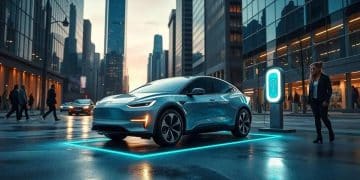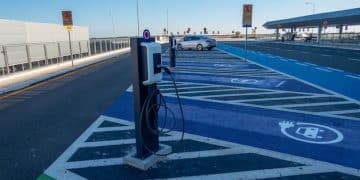Electric Vehicle Wireless Charging: The Future of Contactless Charging Nationwide
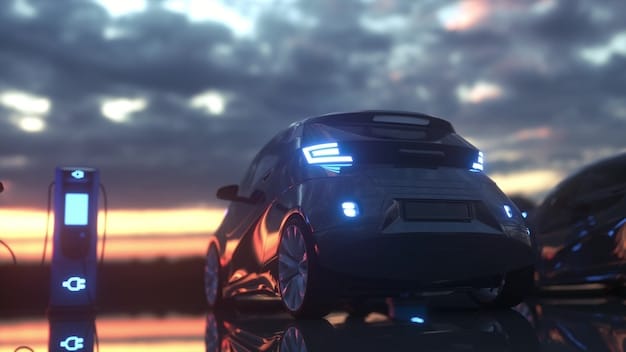
Electric vehicle wireless charging is rapidly evolving, offering a convenient and efficient alternative to traditional plug-in methods, with recent developments paving the way for widespread adoption across the nation.
Imagine a world where electric vehicles charge automatically as you park or drive. That future is closer than you think, thanks to the advancements in electric vehicle wireless charging.
Understanding Electric Vehicle Wireless Charging
Electric vehicle wireless charging, also known as inductive charging, is a technology that allows EVs to charge without the need for cords and plugs. It leverages the principle of electromagnetic induction to transfer energy from a charging pad to a receiver installed in the vehicle.
This technology offers several potential benefits over traditional charging methods, including increased convenience, reduced charging time, and the possibility of dynamic charging while driving.
How Wireless Charging Works
Wireless charging systems consist of two main components: a transmitting pad and a receiving coil. The transmitting pad, typically installed on the ground, generates an alternating magnetic field. When an EV equipped with a receiving coil is parked over the pad, the magnetic field induces an electric current in the coil, which then charges the battery.
The process is similar to how wireless chargers work for smartphones, but on a much larger scale. The power transfer efficiency has improved significantly in recent years, making it a viable option for EV charging.
- Resonant Inductive Coupling: This method uses resonant circuits to improve energy transfer efficiency over larger distances.
- Magnetic Field Shaping: Advanced designs focus on shaping the magnetic field to minimize energy loss and interference.
- Communication Protocols: Sophisticated communication systems ensure safe and efficient charging, monitoring voltage, current, and temperature.
Wireless charging technology is rapidly evolving, with ongoing research and development focused on improving efficiency, increasing power transfer capabilities, and expanding compatibility across different EV models.
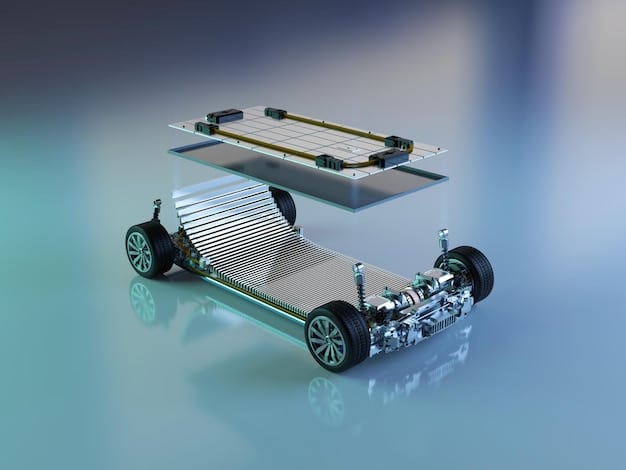
Recent Developments in Wireless EV Charging Technology
The landscape of wireless EV charging is continuously changing, with new innovations and advancements emerging regularly. These developments are pushing the technology closer to widespread adoption and making it more practical for everyday use.
Several key areas have seen significant progress, including improvements in charging efficiency, increased power transfer rates, and the development of standardized charging protocols.
Increased Charging Efficiency
One of the primary focuses of recent research has been to improve the efficiency of wireless charging systems. Higher efficiency means less energy is lost during the transfer process, resulting in faster charging times and reduced energy consumption.
New materials and circuit designs are contributing to these efficiency gains, making wireless charging more competitive with traditional plug-in methods.
Higher Power Transfer Rates
Another critical development is the increase in power transfer rates. Early wireless charging systems were limited in the amount of power they could deliver, resulting in slow charging times. However, newer systems are capable of transferring significantly more power, allowing for faster charging.
This is particularly important for EVs with larger battery packs, as it reduces the time required to fully charge the vehicle.
- Higher Voltage Systems: Increasing the voltage can significantly boost power transfer capabilities.
- Improved Cooling: Efficient cooling systems prevent overheating and allow for higher power levels.
- Advanced Control Algorithms: These algorithms optimize the charging process for maximum efficiency and speed.
These advancements are making wireless charging a more attractive option for EV owners, offering a convenient and time-saving alternative to traditional charging methods.
The Potential Benefits of Contactless Charging
Contactless charging, or wireless charging, offers a wide range of potential benefits for both EV owners and the broader transportation ecosystem. These benefits extend beyond mere convenience, encompassing improvements in safety, accessibility, and grid stability.
By eliminating the need for cables and plugs, wireless charging can simplify the charging process and make it more accessible to a wider range of users.
Convenience and Ease of Use
One of the most obvious benefits of wireless charging is the increased convenience it offers. EV owners no longer need to fumble with cords and plugs, making the charging process as simple as parking their car.
This is particularly appealing for people with mobility issues or those who live in areas with limited access to charging infrastructure.
Enhanced Safety
Wireless charging can also improve safety by eliminating the risk of electrical shock associated with damaged or improperly used charging cables. There are no exposed electrical contacts, making the system safer for both users and the environment.
Additionally, wireless charging pads can be designed to automatically shut off if they detect a foreign object, such as a pet or a child, preventing potential accidents.
- No Cables: Eliminates tripping hazards and potential damage to charging equipment.
- Automatic Shut-Off: Enhanced safety features prevent accidents and injuries.
- Weatherproof Design: Wireless charging pads are designed to withstand various weather conditions, ensuring reliable operation.
Contactless charging offers a compelling combination of convenience, safety, and accessibility, making it an attractive option for promoting the widespread adoption of electric vehicles.
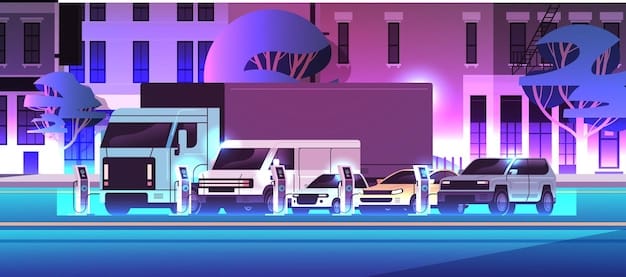
Challenges and Obstacles to Nationwide Adoption
While wireless EV charging holds immense promise, several challenges and obstacles must be addressed before it can be widely adopted across the nation. These challenges range from technical hurdles to regulatory and economic considerations.
Overcoming these obstacles will require collaboration between automakers, charging infrastructure providers, government agencies, and standards organizations.
Standardization Issues
One of the key challenges is the lack of standardized charging protocols and equipment. Different automakers and charging providers may use incompatible systems, making it difficult for EV owners to charge their vehicles at any location.
Establishing universal standards is crucial for ensuring interoperability and promoting widespread adoption.
High Initial Costs
The initial cost of wireless charging systems can be significantly higher than traditional plug-in chargers. This cost includes the charging pad, the receiving coil installed in the vehicle, and any necessary infrastructure upgrades.
Reducing the cost of wireless charging technology is essential for making it more accessible to a wider range of consumers.
- Economies of Scale: Increased production volumes can drive down manufacturing costs.
- Government Incentives: Subsidies and tax credits can help offset the initial investment.
- Innovative Business Models: Leasing and subscription models can make wireless charging more affordable.
Addressing these challenges is crucial for unlocking the full potential of wireless EV charging and paving the way for a future of convenient and accessible electric mobility.
The Role of Government and Industry Collaboration
The widespread adoption of electric vehicle wireless charging will require close collaboration between government agencies, automakers, charging infrastructure providers, and other stakeholders. This collaboration is essential for addressing technical challenges, establishing industry standards, and promoting consumer adoption.
Government support can play a crucial role in accelerating the deployment of wireless charging infrastructure through incentives, regulations, and research funding.
Government Incentives and Regulations
Government incentives, such as tax credits, rebates, and grants, can help offset the initial cost of wireless charging systems for both consumers and businesses. These incentives can make wireless charging more affordable and attractive, encouraging greater adoption.
Additionally, government regulations can play a key role in establishing industry standards and ensuring interoperability between different wireless charging systems.
Public-Private Partnerships
Public-private partnerships (PPPs) can be an effective way to finance and deploy wireless charging infrastructure. PPPs typically involve collaboration between government agencies and private companies, with each party contributing resources and expertise.
These partnerships can help accelerate the deployment of wireless charging infrastructure and ensure that it is integrated into existing transportation networks.
- Shared Risk and Reward: PPPs allow for the sharing of risks and rewards between public and private entities.
- Access to Expertise: PPPs can leverage the expertise of both government agencies and private companies.
- Efficient Resource Allocation: PPPs can help ensure that resources are allocated efficiently and effectively.
By fostering collaboration and providing support, governments and industry stakeholders can accelerate the deployment of wireless charging infrastructure and promote the widespread adoption of electric vehicles.
The Future Vision: Contactless Charging Nationwide
The future of electric vehicle charging is likely to be wireless, with contactless charging becoming increasingly prevalent across the nation. This vision includes dynamic charging while driving, ubiquitous charging pads in parking lots and garages, and seamless integration of wireless charging into the broader transportation ecosystem.
As technology continues to improve and costs decrease, wireless charging is poised to revolutionize the way we power our electric vehicles.
Dynamic Wireless Charging
Dynamic wireless charging, also known as in-motion charging, allows electric vehicles to charge while they are driving. This technology involves embedding charging pads in roadways, which transfer energy to EVs as they pass over them.
Dynamic wireless charging could significantly extend the range of EVs and reduce the need for large battery packs, making electric vehicles more practical for long-distance travel.
Smart City Integration
Wireless charging can also play a key role in the development of smart cities. By integrating wireless charging pads into parking spaces, bus stops, and other public areas, cities can create a seamless and convenient charging experience for EV owners.
Additionally, wireless charging can be integrated with smart grid technologies to optimize energy distribution and reduce the strain on the electric grid.
- Automated Charging: EVs can automatically charge whenever they are parked or stopped at designated locations.
- Grid Optimization: Wireless charging can be integrated with smart grid technologies to optimize energy distribution.
- Reduced Range Anxiety: Dynamic charging can extend the range of EVs and reduce range anxiety.
The future of electric vehicle charging is bright, with wireless technology poised to transform the way we power our vehicles and build more sustainable transportation systems.
| Key Point | Brief Description |
|---|---|
| ⚡ Convenience | Wireless charging offers a hassle-free charging experience without the need for cables. |
| 💰 Cost | Initial costs are high, but government incentives and mass production can reduce expenses. |
| 🛣️ Dynamic Charging | Enables EVs to charge while driving, extending range and reducing battery size. |
| 🏙️ Smart City Integration | Incorporating charging pads in public areas enhances EV convenience and grid efficiency. |
Frequently Asked Questions (FAQ)
▼
Wireless charging uses electromagnetic fields to transfer energy from a charging pad to a receiver in the car. When parked above the pad, energy is transferred wirelessly, charging the EV’s battery.
▼
Wireless charging is improving in efficiency, nearly matching plug-in charging. However, some energy loss occurs during wireless transfer, making it slightly less efficient but very convenient.
▼
Wireless charging systems are designed with safety features. They automatically shut off when detecting foreign objects, and they eliminate exposed electrical contacts making them safer than plug-in systems.
▼
Retrofitting depends on the vehicle model and the availability of compatible aftermarket systems. Check with EV specialists to determine if your vehicle can be equipped for wireless charging.
▼
Dynamic wireless charging involves roadways equipped with charging pads. It has the potential to extend EV ranges by charging vehicles while they’re driving.
Conclusion
In conclusion, electric vehicle wireless charging is rapidly advancing, promising a convenient, safe, and efficient alternative to traditional charging methods. While challenges remain, ongoing developments and collaborative efforts from governments and industry players are paving the way for a future where contactless charging is the norm nationwide.
